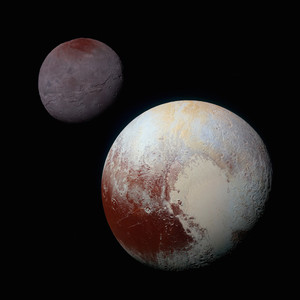Originally regarded as the smallest and most distant of the nine ‘traditional’ planets in the Solar System, Pluto was reclassified in 2006 by the International Astronomical Union as a dwarf planet and is now assigned the minor planet number (134340). This reclassification recognizes the fact that Pluto has many characteristics that distinguish it from the eight planets from Mercury to Neptune. It is far smaller than any of those, with a diameter of only 2377 km, less than that of our Moon. Its orbit has a greater inclination than any of the major planets, 17°.1 to the ecliptic, and its orbit is also the most elliptical (eccentricity 0.25). At aphelion Pluto lies 7375 million km from the Sun, but only 4425 million km at perihelion, inside the orbit of Neptune; it last reached perihelion in 1989. Its mean opposition magnitude is +15. Pluto was discovered in 1930 by C. W. Tombaugh. Its rotation axis is tilted at 122°.5 to its orbital plane, so that its rotation is retrograde, and it presents its poles and its equator alternately towards the Sun and the Earth as it moves around its orbit. Its axial rotation period, 6.387 days, is the same as the orbital period of its largest satellite, Charon, so that Pluto always keeps the same face towards Charon. Two much smaller and more distant moons, Hydra and Nix, were discovered by the Hubble Space Telescope in 2005, a fourth, Kerberos, in 2011, and a fifth, Styx, in 2012.
Pluto
Physical data
Diameter
Oblateness
Inclination of equator to orbit
Axial rotation period (sidereal)
2377 km
0
122°.5
6.387 days
Mean density
Mass (Earth = 1)
Volume (Earth = 1)
Mean albedo (geometric)
Escape velocity
1.9 g/cm3
0.0022
0.0064
0.6
1.2 km/s
Orbital data
Mean distance from Sun
106 km
au
Eccentricity of orbit
Inclination of orbit to ecliptic
Orbital period (sidereal)
5906.4
39.48
0.25
17°.1
247.9 years
Pluto has an extremely thin atmosphere with a surface pressure of about 10 μbar, composed of methane, with some nitrogen and carbon monoxide. This atmosphere may be seasonal, forming when the planet heats up and releases surface volatiles around the time of perihelion. Methane may escape from the atmosphere near perihelion, so that Pluto behaves somewhat like a comet. Its mean surface temperature is estimated at −220°C. Pluto is thought to have a large rocky core, probably surrounded by a layer of frozen water and other icy materials, and a surface layer of methane. Pluto is now regarded as simply the largest of the sub-group of trans-Neptunian objects known as Plutinos. The New Horizons probe flew past Pluto in 2015 July finding apparent cryovolcanoes as well as various formations resulting from surface–atmospheric interactions, glacial flows, and impacts. Cthulhu Regio is an elongated dark area along the equator thought to be composed of complex hydrocarbons (so-called tholins). Tombaugh Regio is a large, bright, heart-shaped area, probably an old impact feature. Its western lobe, Sputnik Planitia, contains frozen nitrogen and other ices which flow like glaciers. These smooth regions are estimated to be less than 10 million years old, indicating that Pluto is geologically active.
 https://photojournal.jpl.nasa.gov/catalog/PIA19952
https://photojournal.jpl.nasa.gov/catalog/PIA19952
The largest known dwarf planet in the Solar System and one of the largest known members of the Kuiper Belt. The existence of Pluto was predicted by calculation by US astronomer Percival Lowell, and the planet was located by US astronomer Clyde Tombaugh in 1930. Its highly elliptical orbit occasionally takes it within the orbit of Neptune, as in 1979–99. Pluto has a mass of about 0.002 that of Earth. Its atmosphere consists mainly of methane and nitrogen and extends about 1 600 km above the surface, perhaps with clouds. Its surface has parts covered by methane and nitrogen ice and other parts by carbon monoxide ice, with mountains towering 3 500 m high and ice-ridge terrain reminiscent of snakeskin. Pluto has five moons, the closest and largest of which is Charon, discovered in 1978 by US astronomer James Christy. Charon is about 1 200 km in diameter, half the size of Pluto, making it the largest moon in relation to its parent planet in the Solar System. It orbits about 20 000 km from the planet's centre every 6.39 days, the same time that Pluto takes to spin on its axis. Charon is composed mainly of ice with surface canyons, the deepest of which plunges 9.7 km deep. The other moons, in order of distance from Pluto, are named Styx (~10 km wide), Nix (~40 km), Kerberos (~25 km), and Hydra (~50 km).
Only one spacecraft has visited Pluto: New Horizons in 2015.

Dwarf planet Pluto and its largest moon, Charon. Image taken by the New Horizons spacecraft on 14 July 2015.
Credit: NASA/JHUAPL/SwRI
http://pluto.jhuapl.edu Comprehensive coverage with images from NASA’s New Horizons mission in July 2015.
Formerly the ninth and outermost planet of the solar system, but now classified as a minor planet, Pluto’s orbit is an average 39.44 AU from the Sun and highly eccentric, sometimes carrying it inside the orbit of Neptune. Its distance from Earth ranges from 4293.7 × 106 km to 7533.3 × 106 km. Pluto is much smaller than the Moon, with a radius of 1137 km; volume 0.616 × 1010 km3; mass 0.0125 × 1024 kg; mean density 2050 kg/m3; surface gravity 0.66 (Earth = 1); visual albedo 0.3; black-body temperature 42.7 K. The atmosphere is very thin, with a surface pressure of about 0.003 bar, and composed of methane and nitrogen. The average surface temperature is about 50 K. It has one satellite, Charon, so large that some astronomers consider Pluto and Charon a double-body system. It was visited by NASA’s New Horizons space probe in July 2015. Pluto was discovered in 1930 by Clyde Tombaugh.